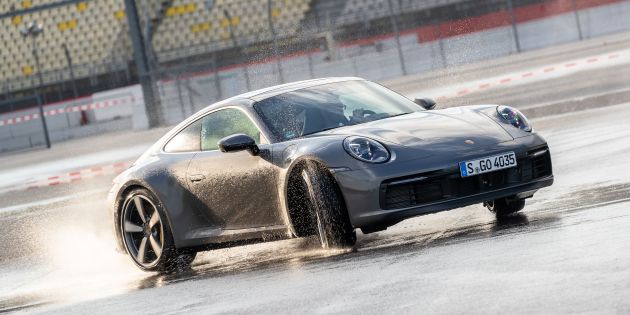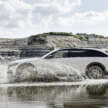
With the spate of rainy weather in Malaysia, incidents of hydroplaning, or aquaplaning, are occurring more often. Just two days ago we were on the highway, riding a motorcycle heading north, and witnessed two incidents of hydroplaning happen directly in front of us.
In both cases, the cars spun, slowed and came to a stop without hitting anything. The drivers were more shocked than anything else, but, what is hydroplaning and what can you, as the driver, do to prevent it or at least, remain in control and recover?
Hydroplaning occurs when water builds up under the contact patch of the tyre(s), causing the tyre to lift and lose adhesion with the road surface. A driver will usually feel this as the steering wheel going suddenly light, then wobbling slightly, before control is lost and everything goes sideways due to the tyres unequal traction.
Several factors directly cause aquaplaning, first and foremost of which is road speed. When road conditions are bad, it is always prudent to slow slightly, pay attention and exercise caution especially with regard to braking distance to the vehicle in front.

While there are some Malaysian drivers who believe and trust in the safety technology installed in their vehicle, every safety system has its limitations. ABS, traction control, electronic stability control, emergency braking and brake assist are technologies that work well and prevent accidents but all require the driver to be in control of the vehicle at all times.
The other main factor affecting hydroplaning is the vehicle’s tyres. In this case, proper tyre inflation pressure should be maintained. Over- and under-inflation will both lead to the vehicle having a propensity for hydroplaning.
Tyre tread depth should also be checked, and if very near or at the wear limit indicators, tyres should be changed either as a pair, or as a full set. In any case, uneven wear on tyres is a cause for concern and indicative of a problem either in the steering alignment or suspension which should be addressed on an immediate basis.
Another factor to be considered is the weight of the vehicle. A very light vehicle, or one that is heavily overloaded, will hydroplane more readily. Try to ensure weight is evenly distributed in the vehicle and balanced fore and aft.

So, what do you do when your car starts to hydroplane? In some cases we witnessed, the immediate reaction of the driver is the jam hard on the brakes to slow the car down but sends the car into a skid. Technically this is when ABS activates to stop the skid and EBD redistributes braking force between the wheels to allow the car to regain stability.
What you can do as a driver is… get better driver training. Steering into and out of skids is not covered in the current Malaysian driving school curriculum, and neither is braking technique, aside from the driving instructor telling you, “just jam the brakes on as hard as you can.”
When your vehicle starts to hydroplane, don’t brake hard or jam on the brakes, instead let the weight of the car settle and allow the tyres to regain traction, then steer into or out of the skid as circumstances dictate. The rule of thumb is you want your steering to be pointing in the direction in which your vehicle is travelling, then reducing steering angle as the car straightens out.
Avoid sudden movements of the steering wheel, or any sudden braking. These serve to upset the balance of the vehicle, leading to an out of control situation.

It is hard to suppress the immediate reaction to emergency brake when you feel you have lost control of the vehicle and indeed, professional drivers train hard against this natural tendency. You should at all times have both hands on the wheel with your seat adjusted to the correct driving position, allowing you to retain command of the important things that control your vehicle when traction is lost, i.e. the steering wheel, accelerator and brake.
Selection of your tyres is as important, as these are the primary contact point between your vehicle and the road. Tyres are not created equal and typically certain brands have a reputation for better wet weather performance than others.
The size of your tyre also plays a part, with a tall, narrow width tyre having less of a tendency to hydroplane than wide profile rubber. Tyre tread type and depth also plays an important part, as mentioned earlier, with some tread patterns specifically designed for all weather and wet weather use while it is best to leave the high performance track tyres for where they should be, at the track.
Road surface is an issue, especially in wet weather. Tarmac tends to offer better grip in wet weather than concrete due to surface porosity and try to avoid puddles and standing water.
Most importantly, keep an eye on your vehicle’s speed and exercise caution. Plan your journey, ensure your vehicle is in road worthy condition and check the weather forecast. Safety on the road is your responsibility.
Looking to sell your car? Sell it with Carro.
















I used yo have a 275×55 R18 tyres and using it during thunderstorm is stressful..i reduced it to 255 and it felt safer during the rain.
Reason why a narrower tyre works is because the tyre has less water to move out of the way (narrower). Another reason is that the tyre patch has less squirm due to a stiffer sidewall for a given rim width. For example, if you use a tyre much wider than the rim, there will be more sidewall flexing and hence more contact patch distortion.
A safe wet weather speed are 80km/h for heavy rain, 90km/h for medium rain and so on. Without knowing the available tread depth, my method is the amount of control I have in my steering when driving in the wet but,… that depends on how sensitive a driver you are
Now I used Michelin tyres and yes it is far better than previous Toyo, Goodyear and not forgetting China’s brand.
So invest a little bit more on tyres and get the best. Never ever using a new H brand car but using 2nd hand tyres. Better using an old Proton or Toyota but with great black donuts.
yes you are right. someone in paultan fb, cant remember the name but he has thesis phd in tyre research (legit), he has website also but cant remember. someone asks, and he said the used/2nd hand branded tyre like michelin is better than new cina tyre, as long as not more than 10 years, no crack and still got bunga. because the rnd and technology is different. there is must be got the reason for being expensive.
Are you talking about us? If we don’t drive jenama H bakal mak mentua xbagi meminang anak dara dia. So we can only sambung bayar jenama H and can’t afford good tyres. Mengharap subsidi ron 95 je la itu pun pinjam duit awek isi minyak
Jgn bazir duit beli jenama maha kaya. Pakai je tayar linglong, sailun, landsail konpem selamat punya la.
You mean ‘selamat’ with apostrophe.
Rule number 1 for safe driving in the rain: have common sense.
Selamat ke kubor…
someone in paultan fb, cant remember the name but he has thesis phd in tyre research (legit), he has website also but cant remember. someone asks, and he said the used/2nd hand branded tyre like michelin is better than new cina tyre, as long as not more than 10 years and stil got bunga la. hmm i think better follow his advice la rather than palatao like you bro. maybe you own workshop jual tyre cina ke?
Sorry but the wording is not clear at all on what to do specifically in braking:
“When your vehicle starts to hydroplane, brake hard, then decrease the pressure gradually…”
You say to “brake hard” which can be easily interpreted as emergency braking.
The next paragraph then says:
“Avoid sudden movements of the steering wheel, or any sudden braking.” Later in the article also says to avoid emergency braking when hydroplaning.
So you ask us to “brake hard”, but no sudden braking or emergency braking. So what is the definition of “brake hard” exactly?
One thing I agree is of course go for driver’s training, and it would be great if PT can recommend any courses that actually teaches these.
Sorry about that. The article has been edited state that braking should be done and at a moderate level. The sentence should have said “don’t brake hard.”
Conclusion. Car should starts back fitting with ford model-T tyres guarantee no aquaplaning right!
every time i see a car flying pass me at 160 on highway during heavy rain, i cant help but imagine the driver is either a pro racer or a naive youngster
in another word, slow down when it rains and driving on slippery wet surface.. don’t be a douchebag speeding during rainy conditions
Apart from choosing a tire with adequate water dispersion channel, the next best thing (and easiest) is actually to ensure you don’t over-inflate your tires. Always follow the load vs tire pressure chart that come with your vehicle.
For simple step, change to a better tyre brands the hydroplanning effect will be reduced. Most of the accident cases on the rain relate to poor tyres condition. Let’s admit that’s at least 50% people are looking for cheap tyres and didn’t pay attention to wet performance. It means there are millions of cars fitted with tyres which potentially poor in wet.
As someone who has been to quite a number of driving classes the recommendation by PAULTAN is very dangerous
When your vehicle starts hydroplaning DO NOT touch your brakes.
Just lift your foot from the throttle pedal, hold your steering as straight as possible and wait for your tires to stop hydroplaning.
Braking while hydroplaning is the main cause of accidents.
When hit by heavy rain don’t just slow down but have the courtesy to move over to the slower lanes. Heavy rain is not an excuse to hog the fast lane at unreasonably slow speed just because you have bad eyesight. We have enough selfish lane hoggers in Malaysia giving birth to more of such types of driver every year. It needs to stop.
shift your gear to 1 to slow down, 3 to straighten out and 4 to accelerate. it’s just 1, 3, 4.
If possible, drive on the middle lanes. Water tends to pool on the sides of the road, so there’s less probability to hit puddles.
Drive at the appropriate speed, adjusting to your ability to scan the incoming road condition. It is better to avoid puddles than tempt fate, regardless of your brand new, expensive, well-grooved branded tyres.
How the cars in front behave can tell you about the road condition and obstacles. Always keep to the appropriate distance and use this to your advantage.
I’m laughing so hard reading this article…
To sudden brake, brake, brake softly when the car hydroplanes….
Gosh…
Normal low standard of writing from this fella
Just write something with no knowledge of the topic, Then do a major edit the article later when the writing is proven wrong by paultan readers and commentators. Usually with zero mention or even acknowledgement of the edit.
Why he is still writing here?
Are you talking about us? If we don’t drive jenama H bakal mak mentua xbagi meminang anak dara dia. So we can only sambung bayar jenama H and can’t afford good tyres. Mengharap subsidi ron 95 je la itu pun pinjam duit awek isi minyak